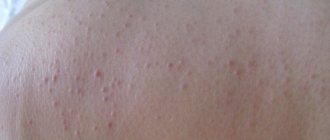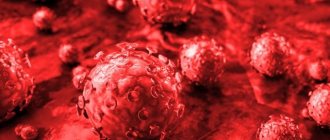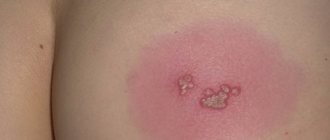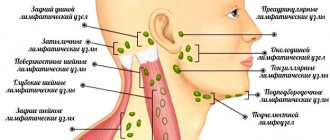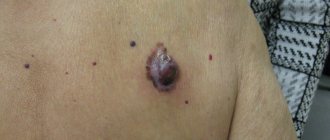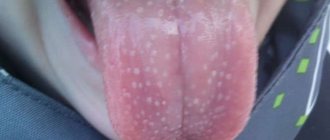Possible causes of allergies
An allergic reaction occurs due to damage to the skin from harsh chemicals or irritants, soap, detergent, and repeated contact with water. Skin contact with allergens such as perfume, rubber or leather can cause rashes in allergy sufferers.
The main causes of an immune reaction:
- Household chemicals.
- Cosmetical tools.
- Nutrition.
- Heredity.
- Professional activity.
Insect bites often cause a negative reaction in the body. In some patients with an immunopathological process, symptoms appear only depending on the season.
Allergic contact dermatitis
Contact allergy on the hands and feet is a form of dermatitis caused by an immune reaction to a material called an allergen upon contact with the skin. The disease is a type 4 hypersensitivity reaction that occurs 36-70 hours after exposure to the antigen. The mechanism involves lymphocytes recognizing antigen on the surface of the skin, releasing cytokines that activate the immune system.
Substances that cause allergic contact dermatitis:
- Fragrances.
- Barium chromate found in cement.
- Preservatives in creams and ointments.
- Titanium dioxide.
- Acids.
- Alkalis.
- Chlorine.
The pathological reaction persists throughout life, so it is necessary to identify the allergen and avoid contact with the antigen.
Allergic urticaria
Human skin contains a small number of mast cells. When activated, white blood cells release histamines into surrounding tissue. When these substances bind to specific structures (histamine receptors) on the surface of blood vessels, the tubular formations expand and their walls become permeable.
Inflammation manifests itself as redness, swelling and itching. Mast cell messenger substances bind to nerve fibers, causing itching. Histamine causes swelling of the subcutaneous tissue when the dermis is exposed to an antigen. Allergies on the hands in the form of red spots appear in waves on the hands affected by a specific irritant.
Atopic dermatitis
Neurodermatitis or atopic dermatitis is a chronic condition that first appears in early childhood. Neurodermatitis on the hands is accompanied by severe itching, which can interfere with sleep at night. Rashes can occur on the scalp, face, neck, upper and lower extremities. Visually, during the acute period of the disease, redness, swelling of the skin, itchy spots of various shapes and sizes, exudation with subsequent formation of crusts are noted. When transitioning to the chronic stage, the skin becomes dry, flaky, and areas of thickening of the skin appear with an intensification of the skin pattern.
There are three age periods of atopic dermatitis:
- infant (up to 2 years);
- children (from 2 to 13 years);
- teenage and adult (13 years and older).
The disease lasts a long time, and other allergic diseases (seasonal rhinitis, bronchial asthma) may occur. In adolescents, rashes may be accompanied by symptoms of vegetative-vascular dystonia (weakness, mood swings, headaches, discomfort in the heart area).
Types of hand allergies
Rashes, blisters and peeling on the hands can be caused by various types of pathology. The manifestation of an allergic reaction depends on what reason provoked the immune response to the irritant.
In the sun
An itchy red rash on the back of the hands is a negative reaction of the immune system to sunlight. Allergies are caused by changes that occur in sun-exposed skin. The organ system recognizes the components of the dermis altered by the sun as “foreign”, and the body activates immune defense against them.
On the water
Symptoms of an allergic reaction to water include redness, flaking, or hives. These changes occur on the back of the hands, in the spaces between the fingers. The skin on the palms is much thicker, therefore more resistant to irritants and allergic rashes.
Hard water, chalky or containing chlorine, causes inflammation in areas of the skin that came into contact with the substance. The rash can appear throughout the year, but worsens during the dry, cold winter months, as a result of the use of hot water, which can irritate the dermis.
To the cold
Hypothermia causes a rash; cold provokes the release of histamine into the body. Redness, swelling, and severe itching develop within a few minutes in the place where the skin comes into contact with the allergen. If a larger part of the limb is exposed to cold, more histamine is released and pain appears.
Allergies on the hands of children
In children, a symptomatic allergy can manifest itself at the first encounter with an antigen. The pathology is manifested by skin rashes of various types, itching. Spots appear on the folds of the arms, merging with each other.
Skin rashes after taking medications, using synthetic hygiene products and cosmetics are more common in young children. Sometimes hives are a symptom of another problem, such as cryofibrinogenemia, cryoglobulinemia, or mononucleosis.
For detergents
Allergic dermatitis to detergents manifests itself in the form of a small itchy rash. The chemicals contained in detergents, when they come into contact with the skin of the hands, cause an immune reaction. The pathological process occurs when the body's cells overreact to chemicals.
The components of detergents and cleaning products for cleaning are synthetic products developed in laboratory conditions. In the production of washing powders, more than 67 thousand different organic and inorganic components that cause irritation are used. The rashes are point-like in nature, with a zone of swelling forming around them. The affected area is very itchy and small cracks form. In more severe forms, swelling of the entire hand occurs.
Allergy from watch on hand
Nickel is a common allergen used in stainless steel jewelry. People who are sensitive to nickel should avoid products made from this metal. An alloy of nickel and zinc, used in the production of plates and bridges in water-resistant watch cases.
A large concentration of chemical microelements can provoke physiological disorders in allergy sufferers. After wearing a watch, a rash occurs on the wrists, accompanied by itching. At the same time, a negative immune reaction is observed not only to the nickel alloy, but also to cobalt and copper.
Allergy to hand cream
People with sensitive skin often experience itchy hands after using skin care products. The occurrence of irritation is the result of chemical reagents included in the cream. The severity of the delayed type reaction is noted after 12 hours, sensitization of lymphocytes occurs. The development of allergic inflammation with minor vascular changes occurs upon repeated contact with the components of the cream.
Advice for patients
To treat the disease, protect your skin from contact with allergens. Observe which substances (detergents, metals, foods, etc.) cause the rash and avoid them.
In everyday life, use only cosmetics intended for sensitive skin and allergy sufferers, or better yet, make such cosmetics yourself. To prevent your skin from drying out and causing new irritations, lubricate your hands with cream or oil. Do all housework with gloves.
Experts also recommend wearing soft, natural fabrics, eating a healthy diet and avoiding stress.
Treatment of this type of allergy is not difficult. By following the tips above and using herbalist recipes, you will eliminate the rash and restore the skin on your hands.
Homemade detergents
To ensure that detergents do not irritate the skin of your hands, they must be natural. We recommend making soap that will not only perfectly cleanse, but also treat the epidermis. Here is the prescription:
- 15 g grated baby soap;
- 1/3 cup oatmeal;
- 1 ½ cups lavender infusion;
- 3-4 drops of lavender essential oil.
Soap and lavender infusion are slowly heated in an enamel bowl, stirring occasionally. Then remove the mixture from the heat and allow to cool slightly, add oatmeal and butter and mix well. All that remains is to pour the product into a greased mold and dry. The soap should stand for a month in a dry place. If you want to clean your hands but don't want to use soap, mix equal parts cologne, lemon juice and glycerin. Beat the white of one egg and mix with a tablespoon of the above mixture. This product is used to treat the skin whenever necessary.
Household detergents can be replaced with soda and laundry soap. They do not contain harmful chemicals.
Elderflower ointment
If you have an allergy on your hands, you need to treat it with natural elderflower ointment. Take 4 tablespoons of Vaseline and 2 tablespoons of dry plant. Melt the Vaseline thoroughly in a water bath, then add the flowers. Let the mixture sit for 45 minutes, warming it occasionally to keep the Vaseline from shrinking. When liquid, strain it and place it in a glass jar. Cool and rub into hands as needed.
Patients diagnosed with hand allergies need to be treated with a mask 2 times a week. Prepare the following ingredients:
- 2 tablespoons finely chopped oatmeal;
- 1 tablespoon of calendula alcohol infusion;
- 1 teaspoon avocado or sea buckthorn oil;
- 1 teaspoon lemon juice;
- 1 teaspoon glycerin.
Mix the ingredients to make a smooth paste and apply on your hands for 20 minutes, preferably before going to bed.
Allergies on your hands will go away if you apply rose water-based cream treatment. Here is his recipe:
- 4 tablespoons glycerin;
- 1 glass of rose water;
- 4 tablespoons cornstarch;
- 3 drops of rose oil.
Mix glycerin, rose water and starch. Heat the mixture in a water bath until it thickens. Let cool, add rose oil and stir. Rub into hands several times a day. Continue treatment until the skin is completely healed.
An allergy to your hands will quickly go away if you treat it with all kinds of baths. The simplest recipe is to immerse your hands in the water in which the potatoes were boiled for 20 minutes. The liquid should have a temperature of about 40 C. Treatment with celery baths helps. Boil a handful of crushed root in a liter of water, cool and carry out the procedure. Baths need to be done at least 3 times a week for them to produce results.
Means for oral administration
Allergy to the fingers is not only a cosmetic problem, but also an internal disease associated with improper functioning of the immune system. Therefore, it needs to be treated not only with masks, creams and other external means, but also with herbal infusions. Healers recommend using the following plants:
- nettle;
- peony roots;
- duckweed grass;
- mint leaves and stems;
- centaury;
- butterbur root.
Make decoctions or infusions from the selected plant. They need to be taken in courses during exacerbations.
(1 ratings, average: 2.00 out of 5)
Diagnostics
An allergist will help you cope with negative reactions and prescribe the necessary tests. Diagnosis of pathology includes:
- Identifying the patient's symptoms.
- Physical examination.
- Study of heredity.
- Clinical blood test.
- Allergen testing.
Newborns with allergies to their hands and feet should be evaluated for food allergies. The doctor will prescribe a biopsy to rule out psoriasis and lupus erythematosus. Skin scraping for microscopy and culture will rule out a fungal infection.
Literature:
- Werfel T., Breuer K., Rueff F et. Al. Usefulness of specific immunotherapy in patients with atopic dermatitis and allergic sensitization to house dust mites: a multi-centre, randomized, dose-response study. Allergy, 2006. - V. 61. - Issue 2. - P. 202-205.
- Clinical allergology. Guide for practicing doctors / ed. R.M. Khaitova. - M., 2002. - 624 p.
- Russian national conciliation document. Urticaria and angioedema. Recommendations for practicing physicians. — Ed. I.S. Gushchina, N.I. Ilyina. - M.: Farmarus Print Media, 2007. - 128 p.
- Instructions for medical use of the drug Cetrin®.
- Kareva E.N. Choosing an antihistamine: a pharmacologist’s view // RMJ. 2020. No. 12. pp. 811–816.
Hand allergy medications
If symptoms of acute inflammation predominate, they are treated with medications. Active ingredients provide suppression or mitigation of allergic reactions. There are different types of antiallergic drugs. They differ depending on the therapeutic effect:
- Antihistamines reduce the effect of histamine on the body. When a person comes into contact with an allergen, the immune system releases histamine, which then leads to typical symptoms of the pathology. Using Elidel ointment or Protopic cream, you can block the action of active immune substances, the symptoms disappear after a short time.
- Corticosteroids reduce inflammation and swelling.
- Medicines for systemic allergies (Azathioprine, Cyclosporine) in the form of tablets, drops or tinctures affect the entire body and relieve symptoms.
- Mast cell stabilizers are used to ensure that histamine and other substances are released into the body only in small quantities. For this reason, stabilizers are used when a chronic form of the disease is diagnosed and the onset of symptoms must be prevented.
- Cortisone is an endogenous hormone produced in the adrenal glands. It suppresses inflammation, which occurs with eczema and urticaria. Treatment with hormone-containing medications is prescribed by a doctor for acute forms of the disease.
Immunomodulatory drugs act directly on the dermis and achieve a quick effect. This dosage form is convenient for the patient because the ointment is applied directly to the affected area. The product works well in the treatment of atopic dermatitis. Synthetic ingredients suppress allergic cells. There are no side effects.
Traditional Treatments
Treatment with medications is prescribed only by a qualified doctor. This type of therapy is used individually for each patient and depends on the patient’s age group and the presence of concomitant diseases. To speed up recovery and get rid of blisters on the fingers, medications such as:
- Antihistamines (excellently eliminate itching between the fingers and promote rapid wound healing): Loratadine, Suprastin, Fenistil and their analogues.
- Antiallergenic agents (in this case, calcium gluconate is used, which helps suppress immune reactions).
- Enterosorbents (activated carbon, white carbon, Smecta, Enterosgel are used only to eliminate an allergic reaction from food poisoning).
- Corticosteroid drugs for external use (ointments contain hormones that have strong antipruritic and anti-inflammatory effects; it is not recommended to base treatment therapy on such drugs, because they are addictive; after corticosteroid therapy, it is worth switching to lighter drugs).
- Emollient creams (the rash on the fingers may disappear after constant use of this product; a cosmetic-type drug is considered an essential remedy for chronic allergies).
There are common cases where blisters or rashes cause severe itching, after which wounds form. In this case, doctors recommend that patients take antibiotics in order to prevent decay and rapid healing of wounds.
Folk remedies
Treatment of allergies with folk remedies in adults and children involves the use of decoctions and ointments. Symptoms of immune pathology in older people are more pronounced than in children, and the therapeutic course is 10-14 days.
Coltsfoot ointment
Allergic swelling of the hands will help relieve ointment based on coltsfoot. Recipe:
- 100 g coltsfoot leaves twisted through a meat grinder;
- 30 ml milk.
The ingredients are combined and heated in a water bath for half an hour. The resulting mixture is cooled and applied to the affected areas of the skin. The ointment is used to treat contact dermatitis.
Egg and vinegar ointment
A product based on chicken eggs with the addition of vinegar reduces the manifestations of allergic dermatitis. To prepare the ointment you will need:
- Egg.
- Vinegar 9% – 50 ml.
- Purified water – 50 ml.
The mixture is stirred until a homogeneous mass is formed, sealed and placed in a cold place for 30-45 minutes. Apply a thin layer to clean skin at night. Wrap with film and on top with cotton cloth.
Eczema
Eczema is a chronic inflammatory skin disease characterized by the appearance of a polymorphic rash and severe itching. True eczema is manifested by redness and limited swelling of the skin, on which small blisters appear filled with transparent contents2. After opening the bubbles, erosions remain, which eventually become covered with crusts. In the chronic form of the disease, the skin thickens. The rashes are symmetrical, most often occurring on the upper, lower extremities and torso.
Disease prevention
Low immunity contributes to the development of the disease. To strengthen internal defenses, doctors recommend using a complex of dietary supplements. Lack of vitamin A and E impairs skin regeneration, exacerbating the problem.
Controlling and preventing allergic reactions depends on the type of disease. Ways to cope with pathology:
- Reduce exposure to antigen.
- Wear gloves when going out into the cold.
- Do not wash dishes in cold water.
- When cleaning using chemicals, wear rubber gloves.
- Keeping a diary of symptoms.
- Changing your diet.
Allergen-free hand creams with plant extracts have a soothing effect. Therefore, after contact with household chemicals, it is necessary to use products that moisturize and nourish the skin.
Main methods of treatment
Very often, allergies that occur on the skin are characteristic of a child. This, in turn, means that this condition will go away as the child grows up. However, there are frequent cases when this condition develops into asthma in adulthood. After all, allergies are often associated with the mental characteristics of the child. As a preventative measure, consultation with a psychotherapist is recommended.
Most often, to treat the skin of the hands, which itches unbearably and causes discomfort in a child, the following are used:
- Hormonal corticosteroid ointment;
- Various emollient creams that help soften and moisturize the skin of the child’s hands;
- If there is a cold allergy, it is recommended to limit the cold that affects the skin by wearing mittens and warm gloves;
- If the skin is very itchy and causes severe discomfort, antihistamines are used to reduce itching;
- The use of a product such as Riciniol will also reduce the manifestation of an allergic reaction. What is Riciniol? Let's look at this drug in more detail.

